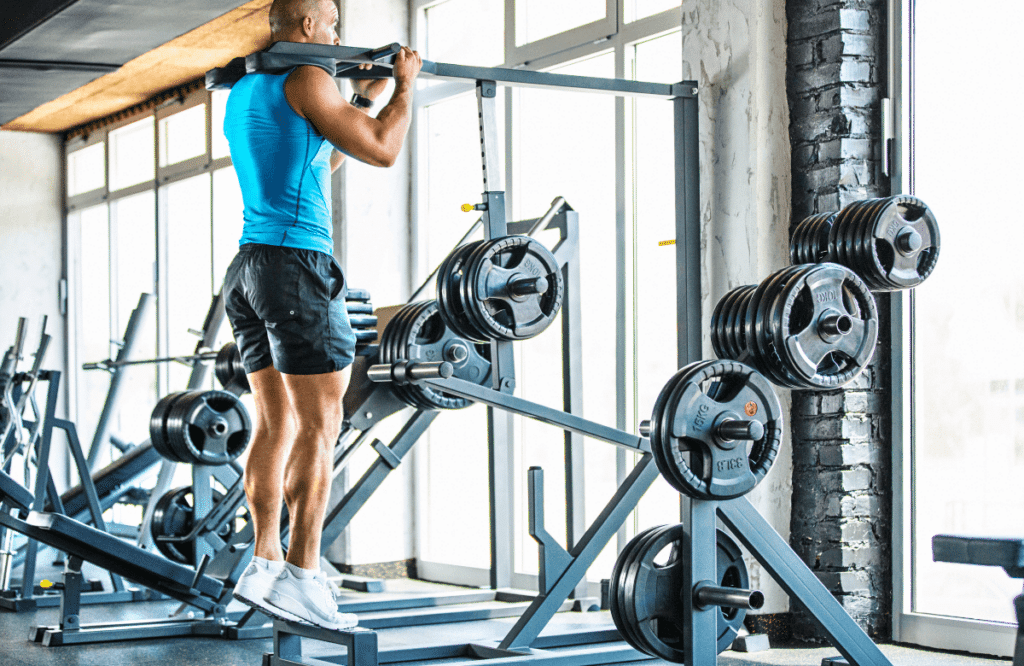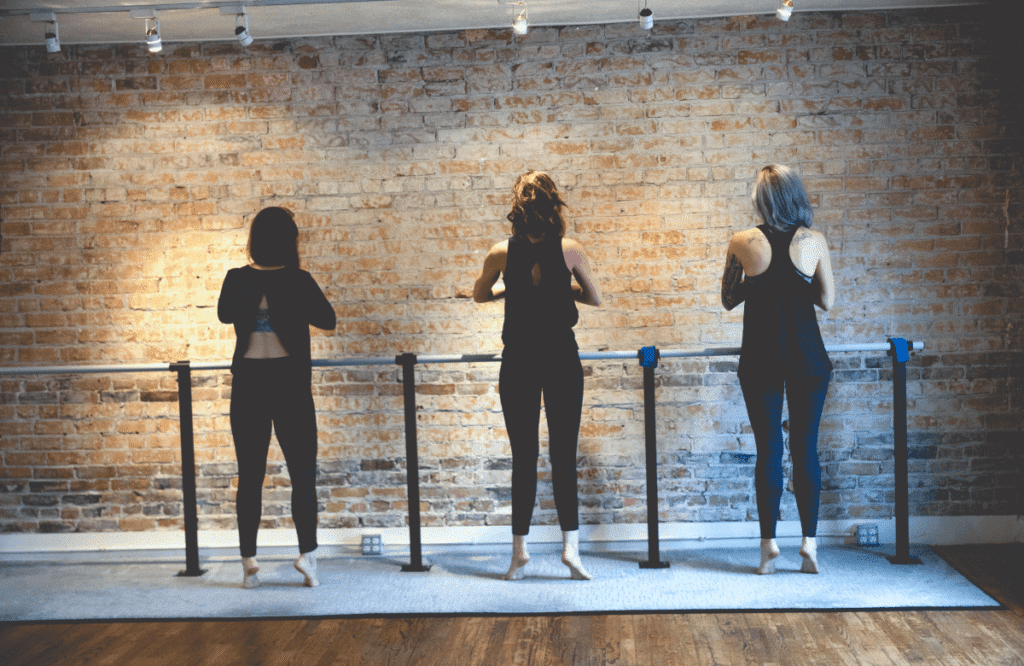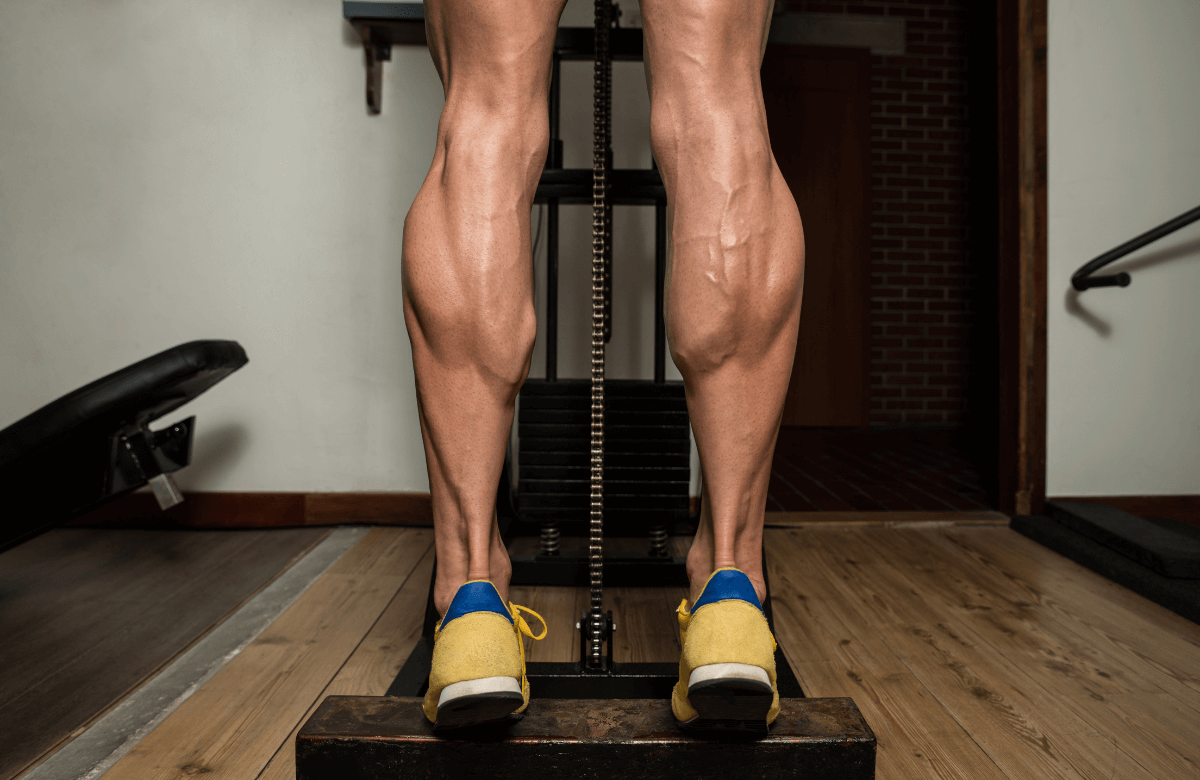A lot of people forget about the calves in their strength program. But ankle stability is important for performing compound exercises and daily movements like walking. In this article, we are going to tell you what calf raises are and how to do calf raises. Let’s get started.
Jump to:
What Are Calf Raises?
Calf raises are a simple exercise that activates calf muscles. It’s an isolation movement because it trains just one primary muscle group. There are a lot of variations of calf raises. You can mix them into your leg workouts to get better results.
Muscles Worked by the Calf Raise
The purpose of this exercise is to strengthen the gastrocnemius and the soleus also known as the calf muscles. These muscles play an integral part in plantar flexion at the ankle which also has a major role in allowing you to propel forward when running or sprinting as well as jumping.
Basically, pointing your toes down, you target both the 2-headed gastrocnemius muscle and the underlying but larger soleus muscle.
One important point to note is that the gastroc is a bi-articular muscle meaning it crosses both the knee joint and the ankle joint. So, it can also flex the knee which is why it’ll be active on leg curl movements. And because there is some degree of ankle plantar flexion on squats and deadlifts, the calves will be somewhat active there as well.
But the plantar flexion range of motion is pretty small; that’s why it’s necessary to train the calves directly to maximize their growth potential.
Because the soleus crosses only the ankle joint and not the knee joint, it’s probably better targeted with a bent leg calf raise. While the gastroc is better targeted with a straight leg. However, both the gastrocnemius and soleus muscles will be active any time you plantarflex regardless of the knee position. So, using both a straight leg and a bent leg option in your training makes the most sense.

Benefits of Calf Raises
1. Building Large Calf Muscles
Calf raises target the muscles on the back of your lower legs, particularly the soleus muscle close to your Achilles tendon and the gastrocnemius muscle that goes down your leg.
2. Increasing Ankle Stability
It increases the stability and mobility of the ankle because by performing calf raises you strengthen your calves, which protect your ankles. This effective exercise provides you with the ability to stabilize yourself in strength-based and explosive movements.
3. Strong Calf Muscles
Calf raises can boost your power. It’s a significant benefit because we are using our calves during a lot of activities, for example, walking, running, and swimming. Also, we engage these muscles when we perform traditional compound movements like squats and lunges. If you perform squats with heavy weights and your calves are not strong enough for this, you can get injured.
How to Do a Standing Calf Raise: Calf Raises Proper Form
It’s so easy to cheat on calf exercises, so it’s especially important to put technique first.
To begin a basic calf raise, you are going to stand next to an aerobic step or block. You will then place the balls of your feet on the edge of that step or block. Let your heels drop down as far as possible. You will begin to feel stretch in the lower leg muscles.
Slowly raise your heels up as high as possible squeezing your calves at the very top of that range of motion. Hold for about a second and then you will slowly return back to the starting position. Repeat this for 8 to 12 repetitions and complete about 2-3 sets.
Tip #1: Point Feet Inwards and Outwards
Foot angle makes a difference to the head of the gastroc being targeted. If you point your feet inwards, you will target the lateral head. Pointing your feet outwards hit the inner (medial) head. To hit both heads, keep your feet pointing forwards.
Tip #2: Perform Full Range of Motion
Not doing it is a huge, unbelievably common problem in calf training. The thing is your calves respond super well to a ton of actual movement.
When you do your calf raises, make sure that you go all the way down until you are physically incapable of descending. You can arguably sit there for half a second to make sure you’ve hit it and apply a deep stretch. And then come all the way up to the peak contraction where you are up on the balls of your feet. Failure occurs when you cannot hit your peak contraction anymore.
Tip #3: Rest For 10 Seconds
Take 5-10 seconds of rest between every set and you burn your calves out stimulating massive gains. You don’t have to rest for 2-3 minutes between calf raises.

Common Mistakes
1. Improper Foot Positioning
This doesn’t allow you to go all the way down so you’re just pretty much standing on your tippy toes. You will be missing a good chunk of the movement. So, avoid making that common mistake.
2. Stopping Short at the Bottom
You’re only going to be doing half the movement. A lot of people do this because the weight’s too heavy and they’re rushing through it.
3. Uncontrolled Descent
The eccentric phase is super-important to growth and especially it seems so for the strong calves if you’ve ever had any experience training them. It’s super easy to slack off, just start counting reps, doing a ton of weight, and not taking your time.
You don’t have to do five seconds on the way down but you have to strictly control all the way down. So, go slow and also give it a half second or a second at the very bottom to get that deep stretch and then come back up. That tends to prevent rushing.
4. Bending Knees
The next common mistake is to bend your knees when you’re coming up. It’s a little easier because you can put on more weight. But it may actually take some tension off of the calves themselves and specifically of the gastrocnemius which you want to be training a lot when you’re doing this exercise.
Make sure you keep your leg straight. Don’t be tempted to do a little jump at the end bending your knees. That counts as an extra rep but it doesn’t give you as much growth and potential as keeping it strict and potentially taking failure earlier.
5. Extreme Strictness
The next mistake is the pursuit of excessively extreme strictness. Some people think the calf raise should be done off your very tippy toes. They think that when they come up at the top of a calf raise, they should again come up on their very tippy toes.
It turns out that a lot of that may be limited by your foot strength and a lot of times when you’re just on your tippy toes, your central nervous system won’t even drive that hard to your calves because it doesn’t think you’re stable. So, it ends up costing you calf activation even though mechanically, from a technical perspective, it loads the calves the most hypothetically if you could turn them on.
Instead of trying to go for the tippy toes idea, make sure the balls of your feet are solidly on the actual step, and then the rest of your foot is off. And when you come up, just make sure to come up on the balls of your feet. And you don’t have to come up on your toes.

6. Limited By Grip
We mean the grip of your feet. Try to wear shoes with a nice grippy surface. If you find that your shoes aren’t working well, you can even try just your socks. Sometimes that works better.
If you have a choice of surface, find the surface or a step that gives you as much grip as possible. Some steps are laminated, carpeted, or too slick and don’t allow you to have stability.
7. Feet Angles and Width
It’s okay to use multiple arrangements of feet and toe angles in order to have some variation. Use whatever you want. But if you’re trying to work in a position that absolutely doesn’t feel great for your calves, you don’t have to do this.
8. Dumbbells
If you have a dumbbell, which arm do you hold it in? Make sure you switch the dumbbell side to side to keep balance.
9. Heavy Weight
The last mistake is going too heavy on calf raises. Usually, there’s not enough stability, especially on calf raises on the stairs. The reps are very difficult to pull off with good technique and the mind-muscle connection gets replaced with just trying to lift the weight. It becomes difficult to control the eccentric, get a peak contraction, and make progress.

How Many Calf Raises Should I Do?
Load the calf raises with light and heavy weights 15-20 reps. The most recent evidence on this suggests that both the soleus and gastroc muscles are type-1 dominant. So, this muscle group benefits from the use of higher reps.
Do 1-2 priming sets with bodyweight first to get used to taking your calves through a full range of motion. It helps you establish a mind-muscle connection and get your ankle joint loosened up first. At this point, you’ll want to make sure that you’re able to fully stretch your calves at the bottom.
If you perform calf raises every day for one month, you should begin to notice a difference in your legs.
Variations of the Standing Calf Raise
1. Dumbbells Calf Raises
Hold a dumbbell in each hand. Raise on your toes, then lower the heels all the way to the floor.
2. Front Foot Elevated Dumbbell Calf Raise
You can intensify this isolation exercise by holding at the top and pulsing through a small range of motion. This places more time under tension for the gastrocnemius.
3. Barbell Calf Raises
Firstly, you want to set up with your feet pointing straight ahead. Lower your heels keeping tension on the back of your legs and then push with the balls of your feet and raise your body straight up.
4. Smith Machine Standing Calf Raises
You can easily do standing calf raises on the Smith machine if you don’t have a standing calf raise machine available.
Make sure your feet are parallel at all times and do not let them move farther apart or closer together. Keep all your weight on the balls of your feet and your body upright. If you’re on a Smith machine, make sure you’re standing on top of some weight plates or a riser.
5. Standing Calf Raises Without Weights
This easy-to-follow exercise will help to keep your calves toned. For this calf exercise, you will need a step. You can do this exercise at home or in a gym.
Stand with your feet one-foot wide apart on the step. Hold on to something to keep your body weight balanced. A wall is a good idea. Make sure the weight is on the balls of your feet and your heels are hanging over the edge.
6. Standing Calf Raise Machine
Firstly, aim for the pad to be around shoulder height to start off. If it’s too low, you’re going to have to crunch. It’s going to be very uncomfortable. And if it’s too high, it’s also going to be very uncomfortable and you’re not going to be able to reach it properly.
Once you get set up and situated in the machine at the proper height, stand right up. The main goal of this is obviously to focus on the calves and get a nice contraction controlling the weight. Obviously, try to use a weight that you can control to get the best result.
7. Donkey Calf Raise
You can easily set up this basic old-school exercise on a Smith machine. It’s been shown in some independent EMG data to have the highest muscle activation out of the 6 variations tested.
8. Single Leg Calf Raise
This exercise will help you avoid asymmetries from having one calf take over. One of the biggest things is focusing on the control for 2-3 seconds on the way down. Make sure you avoid rushing through the movement.
Calf Raises Proper Form: FAQs
What are calf raises good for?
This exercise decreases risk of injury and increases the stability of ankles because it targets calf muscles. This major muscle group is responsible for the foot’s ability to move downwards and upwards. So, it adds some muscular output when you perform squats, lunges, and sprinting.
Is 100 calf raises a day good?
It’s good and healthy to perform 100 calf raises per day. You can definitely do it and add this exercise to your daily exercise routine.
How many calf raises per day?
For most people, doing calf raises in the 10 to 30 range on a first set is enough. Perform 3-4 sets with 10-second rest.















